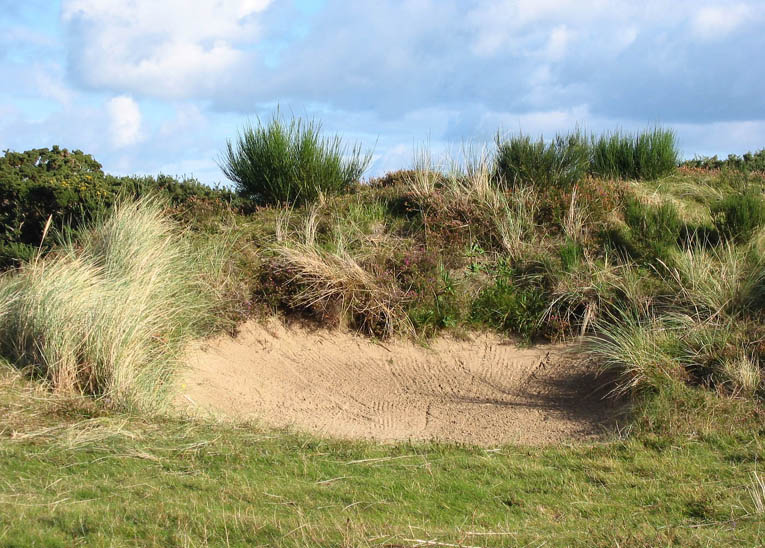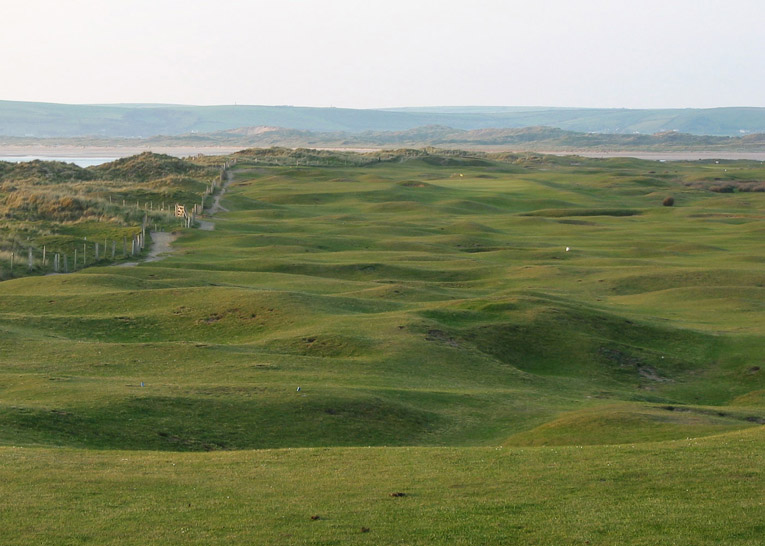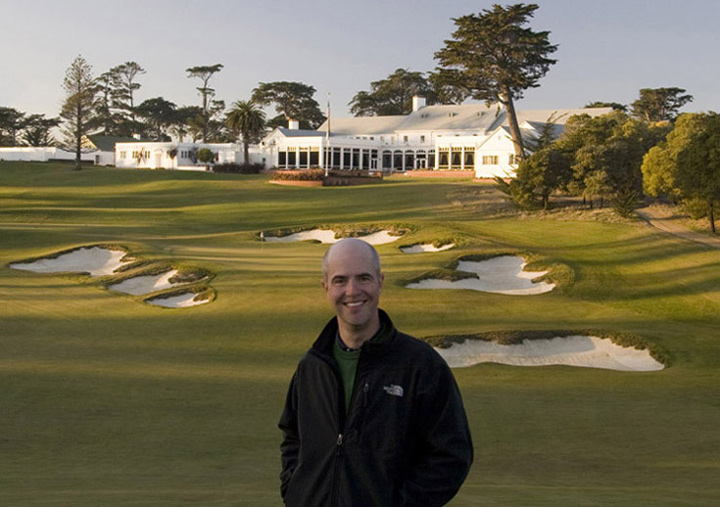Feature Interview with George Waters
pg. 2
11. Just because a course is built on sand doesn’t automatically confer greatness to it. What design mistakes have you seen architects/owners make on sandy soil?
The worst mistake an architect or owner can make on a sandy site is to approach the project as if it were a typical course. This applies to the design, shaping, finish work, grass type selection, seeding rates, maintenance regime, cart policy, all the way along. A sandy site has to be treated differently to get the most out of it. Because there is so much opportunity inherent to the terrain, the saddest outcome on sandy ground is when the course ends up looking and playing like just another golf course.
12. Your travels span the globe. What five designs most impress you for their set of green complexes?
Pacific Dunes, Muirfield, The National, Pine Valley, The Old Course
13. What five designs most impress you for their use of hazards?
Pine Valley, The Old Course, The National, Royal Melbourne, Cypress Point (including the ocean as a hazard)
14. What five designs have used sand based vegetation to enhance the charms of a round there?
Royal County Down, Friars Head, Kingston Heath, Bandon Trails, Swinley Forest

The bunkers at Royal County Down are fringed with a variety of native plant materials to wonderful effect.
15. The vast majority of courses – tragically – aren’t built on sand. What, if anything, can people at such courses take away from studying sandy courses?
One important lesson is that making courses wider and more playable doesn’t in any way diminish their quality. Wide fairways and swaths of short grass around greens are common among sandy courses. These features allow more strategic options to be built into the design, and allow for a bit more forgiveness and fun for the vast majority of golfers. As I say in my book “Too many golf courses focus on separating a good shot from a bad one. The real goal should be to separate a good shot from a great one, while allowing the bad shots to eventually find their way home.” This applies equally to any course.
Another important lesson is that conditions don’t have to be wall to wall perfect for a course to fun and enjoyable, indeed courses can be more fun with a bit of roughness here and there. Finding some irregular or imperfect lies makes the game more interesting, and tests a player’s judgement and patience. The photo from Westward Ho! on page 32 of Sand and Golf illustrates this pretty well. Conditions there may not be uniformly world class, but the golf certainly is. In fact I had one of the most enjoyable rounds of my life there and the roughness helped make a great design even more fun. Courses on sandy terrain are famous for incorporating a little natural imperfection into the golf experience and other courses would benefit from the same, especially if it led to lower green fees and a healthier bottom line.
An emphasis on walking, as opposed to taking a cart, is another lesson that can be learned from courses built on sand. While carts help golfers get around a course, and provide a source of revenue, they also dramatically alter how a course can be maintained. The wear and tear that comes with carts means the turf needs more water and fertilizer to recover. This places courses on a path to lush, soft conditions, essentially putting the cart before the course. For this reason, most of the classic links, and many of the best modern courses built on sand, have serious restrictions on cart usage. This helps them provide firm and fast conditions without wearing down the turf with cart traffic. It also promotes a more vigorous and sociable style of golf. I’m not exactly sure how we change the cart culture, but it would be a major step forward if we could. Incidentally, I do not find the ability to keep one’s smart phone readily accessible to be an advantage of cart usage.

Sandy courses like Westward Ho! show that a little natural imperfection doesn’t diminish a great golf experience.
16. What three non-sandy courses impress for their random landforms and shaping?
Most of the best examples of random landforms and interesting shaping I’ve seen away from sand have been on rocky terrain. It’s funny because on sandy courses you often find great shapes and landforms because people didn’t see any reason to bother changing them. On rock you find great shapes and landforms because people couldn’t change some of them if they wanted to (without blowing the dynamite budget). Rock Creek Cattle Co had natural landforms that were the closest I’ve seen to linksland on a non-sandy course, except that instead of sand under each of those “dunes” it was a pile of refrigerator sized rocks. I also really like the landforms and shaping at Stone Eagle, another rocky site, this time in the desert above Palm Springs. Victoria Golf Club in British Columbia, is another favorite of mine, and again it’s the irregularity of the underlying rock that explains the many cool, small scale contours.
17. You are 35 years old and have had the privilege to work at some of the world’s best courses (Barnbougle, Sebonack, Pinehurst Number 2, etc.). What sandy regions will offer future building opportunities to your generation? Investors these days clearly appreciate the financial risks inherent in building on remote, though sandy, sites.
I think remote sandy sites will be part of the picture, though we’ll have to see if places like the Sandhills have already reached their carrying capacity for golf. It sounds like opportunities continue to exist on the remote stretches of North America’s coastline, though perhaps less and less frequently. Australia certainly has plenty of opportunity for golf development on sandy terrain and a great golfing culture to go along with it. There are also the largely untapped sandy regions of South America, including some fantastic coastal dunes. I’m hoping that Gil Hanse’s course for the Rio Olympics proves to be a great demonstration case for the value of golf on sandy terrain and perhaps someday there will be a boom in South American golf that has sandy terrain as its foundation.
Many of the best opportunities lie with existing courses built on sand that are not making the most of what the terrain has to offer. I have seen too many courses that are blessed with great sandy terrain, and yet fall short of their potential. You can’t help but think how great they could be if they were redesigned in a way that made the most of the site and soil. While there may be too many golf courses in the United States, there is a relative scarcity of really good ones. Existing courses situated on sand have a huge advantage over nearly any competing course, and renovating them doesn’t include the same degree of regulatory hassle that comes with developing a new sandy site.
18. Rules and regulations can make building in sandy sites slow going from an approval perspective. What points would you make to such regulatory bodies if they were reviewing a Waters master plan?
There is a perception in some circles that golf courses are anything but “green”. However, many of the environmental issues associated with golf course development have less to do with golf than with building courses on unsuitable terrain and trying to maintain them to manicured perfection. Because golf is a product of sandy environments, it is much easier to harmonize a course within those landscapes. Many of the shapes and features that make for great golf are already present on most sandy sites, meaning the construction process can be more sensitive to the existing landscape. Indeed, on many sandy sites, the less you do the better the course will be.
In addition to designing with nature, it is much easier to maintain a course built on sand in an environmentally responsible way. The deep rooted turf grasses that thrive in sandy terrain require less water and fertilizer. There is also typically less pesticide usage on courses built on sand. The best managed sandy courses place their emphasis on fun and playability above difficulty and perfect conditions. A willingness to accept some natural imperfection allows for a much lower-impact maintenance program.
Courses built on sand also have the potential to preserve, and even enhance the natural processes of the surrounding landscape. The dynamics of wind, water, plants, and animals that created the original fairways, greens, and bunkers can continue to function within the context of a modern golf course. For example, areas of exposed sand are critical to the ecology of most sandy landscapes. The presence of moving sand helps maintain the unique plant and animal communities that thrive in sandy environments. Incorporating moving sand as a hazard or native area offers strategic and aesthetic benefits to a golf course while simultaneously preserving the landscape’s unique ecology. Golf development can also be an effective vehicle for restoring damaged or poorly functioning sandy landscapes. Courses like Sebonack, Chambers Bay, and Streamsong all helped to improve the ecological value of their sites in addition to adding first class golfing and recreational value.
Another concern people have about golf development is that it will preclude any other activities on that site. People worry that land developed for golf will be a playground for the rich that doesn’t benefit the community and may even degrade the environment. Courses built on sandy terrain have a long tradition of existing in harmony with both their environment and their community. The original links courses were built on common land because the nutrient poor soils were of little value for farming. The open access and ideal natural conditions helped golf to flourish in these public spaces. Today many of the best sandy courses rest on land that belongs to everyone, where golfers and non-golfers alike are able to share the same space. There are countless examples of first rate sandy courses that double as wonderful community spaces, with the Old Course at St Andrews being the most famous. Modern examples like Chambers Bay show that the principles of shared space and community within a golf context can still thrive today.

Streamsong is a great example of how golf can be used to enhance the ecological and recreational value of a sandy site, in this case a former Phosphate mine.
19. Your liberal use of photographs helps drive home your various points/observations. Did you really take them all?! Many are outstanding and the one of the Ladies Putting Course at St. Andrews is a personal all-time favorite.
Yes they are all mine. I took them over a period of maybe ten years, often seeing a good shot and returning later in the day, the next morning, or even on another visit to catch the image I was looking for. Even with all my best laid plans however, if I hadn’t spent hours on end just walking around these courses I would have missed a lot of special photo opportunities. My photos from Rye are good examples. It had been overcast and miserable during my entire round and nearly all of the evening. The front finally blew through in the last hour of daylight, letting me get some great low-light shots that really brought the contours to life. It was the only day I spent at the course, and if I hadn’t hung around until the very end I would have missed a great opportunity.
It also helped that I’ve had this book in the back of my mind for a long time and had been writing short sections whenever I encountered something worth highlighting. I knew there were certain photos that I was going to need and I chased after them pretty enthusiastically. I had to jump up from dinner with Tom Doak in Dornoch when I looked out the window and saw the evening sun finally poking out from under the clouds. I ran up the hill, got some shots of #2 and then sprinted across the course to get a photo of the green at Foxy just as the light was running out. I made similar mad-dashes from my apartment in North Berwick anytime it looked like the evening light was going to be good at the West Links. There were holes, and even specific contours, out there that I knew I wanted to document for potential use in the book. Over the course of a summer I was able to get the shots I needed. The photo of the Ladies Putting Course was a stroke of luck. I was upstairs in the New Clubhouse at St Andrews when I noticed there was a cool view down onto the green. The light was poor at the time but later on it suddenly improved. I was out by #6 green on the Old Course at the time, ran into the clubhouse and managed to get up onto the rooftop where there was a great view of people enjoying the green.
20. Who is your target market for this book?
First and foremost I wrote Sand and Golf for golfers, weekend players and architecture experts alike, anyone whose enjoyment of the game might be enhanced by some insights into how sandy courses work and what makes them special. I hope Sand and Golf captures people’s imagination and makes them want to visit the courses described within. It should help visitors to those courses understand them better and enjoy their experience more.
Sand and Golf should also be of interest to people that work in the golf industry, including general managers, golf professionals, superintendents, and architects. It describes the unique characteristics shared by courses built on sand special and explains the interrelationship between design, construction, maintenance, and management that is required to get the most from the terrain. Although my book deals specifically with courses built on sand, many of the broader concepts apply to golf courses in almost any landscape.
21. As the winner of the prestigious GolfClubAtlas.com 2013 Golf Architecture Book of the Year award, who would you like to thank?
First I’d like to thank the Awards Committee for selecting Sand and Golf. I wrote the book hoping it would be appreciated by informed golfers, but I hadn’t expected anything like this. The editors and contributors to GolfClubAtlas have always been very kind to me. The website is a unique community and resource. It has certainly played a role in my golf architecture education and influenced some of the discussion in Sand and Golf.
I also have to thank the golf course architects I’ve worked with over the years. They all took an interest in me, included me in projects, and spent lots of their personal time teaching me what they had learned over their careers. Tom Doak, in particular, has been a good friend and mentor and I really appreciate the thoughtful Foreword he contributed to Sand and Golf. Bill Coore has also been very nice to me over the years, letting me tag along with him around Bandon Trails, sharing his thoughts with me while we worked on Pinehurst Number 2, and being willing to answer the phone and give the occasional recommendation for courses I should see. Jim Urbina has probably introduced me to more sandy courses than any other person I’ve worked with and he is directly responsible for lots of the material in this book. Jeff Mingay, just as passionate about writing as I am, has been an excellent sounding board for ideas about this book since its early stages. We have had a lot of fun working together and he has given me some fantastic opportunities to grow as an architect.
I have already mentioned Brad Klein, Paul Daley, and the help I received from my publisher Goff Books. In addition I’d like to thank Kyle Franz, who has been a good friend and a great supporter of my career. I was proud to play a role in the very successful restoration he performed at Mid Pines earlier this year. I also owe a lot to the design associates at Renaissance Golf, who have been great teachers, colleagues, and golf buddies.
Personalized copies of Sand and Golf – How Terrain Shapes the Game can be purchased directly from George at email gwatersgolf@yahoo.com.
THE END








